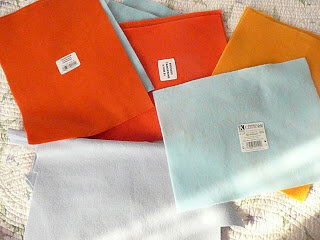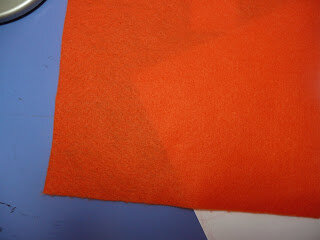Wool and Synthetic Felt
Reported by Susie Ziegler
One of my favorite materials to use in hand stitching and crafting is felt. Felt is readily available at craft retailers but there are several types. I went out and purchased a selection to compare for you, crafty readers.
The first and most beloved type is 100% wool. This felt is reported to have an almost mystical perfection but is really expensive and is only available online or at specialty outlets. I'm sorry to say that I did not purchase or test this felt. I can only go by the word on the street that says it is fantastic.
Another type of felt that you can actually find at stores is also commonly called "wool felt" but is really a wool/rayon blend. American fabric retailer JoAnns has a selection of this felt manufactured by National Nonwovens at about $10/square yard. I'll disclose right away that this is my favorite felt and I have a good sized stash of it in every color. JoAnns only carries a small selection, unfortunately, so I usually need to go online to get certain colorways.
Most commonly available in craft stores is synthetic felt made from acrylic or polyester. JoAnns and WalMart both carry a nice synthetic by Kunin Group made from 100% recycled bottles. Priced at under $4/yard for a large 72-inch width, this felt is an excellent value. Squares of this Ecospun polyester felt are stacked in the craft area and are about 20 or 25 cents each.
Finally, at Michaels and Hobby Lobby, I found 20 to 25 cent acrylic felt squares of unknown manufacturer. Hobby Lobby's acrylic felt was the softest and fuzziest. Michaels' was also soft, but thinner and more dense.
Wool/Rayon felt has the most "natural" feel for obvious reasons. Acrylic is slightly scratchy. Actually all felt is slightly scratchy and if you are allergic to wool, I suppose you would be scratchiest of all using felt of that fiber. I noticed that the acrylic felt has a slightly glossy sheen to it. Many people prefer it for this very reason. In this photo, my wool felt is the darker dull cut leaf on the far left.
Sometimes I use hole punches on felt to get uniform pieces more quickly. Whenever I've tried hole punching acrylic felt, the results are disastrous. Wool felt punches easily, although there are usually a few fuzzies to trim off with scissors. You can die cut all types of felt with heavy duty die cutting machines like a Sizzix. Thin dies designed for paper like the Cuttlebug will not work at all. Don't even try it. Just trust me...
One of my biggest problems with synthetic felt is that it is too translucent. I want my applique projects to stay true to their color and not have the backs of my threads and patterned fabrics showing through. Look how easy it is to see the paper behind this felt square from Hobby Lobby.
I was surprised to find that the synthetic felt squares I saw at Michaels were reassuringly opaque just like my wool/rayon blended felt. Different colors of synthetic felt will have varying levels of translucency.
I washed small felt squares and the felt all held up well in my regular laundry wash and dry cycles. Only the wool felt shrunk considerably and had marked change in its texture. The synthetic felts all came through the wash virtually the same as they went in although just a little bit fuzzier.
All felt will pill and fuzz over time depending on how you use it. Note on this purse applique that the blue synthetic felt has pilled the most. The other colors are natural fibers.

I use felt in little handstitched appliques and small felt mascot projects. Ease of cutting and stitching are important to me. I find that synthetic felt drags against my needle when I am stitching and resists my scissors when I cut. Friends of mine who hand stitch felt find that this does not bother them and they like the synthetic felt because of it's availability.
Wool Blend Felt
Pros:
- Cuts well
- Opaque and dense
- Natural feel
- Does not pill as much over time
- Considered "premium"
Cons:
- Shrinks when laundered
- Expensive
- Hard to find
Synthetic Felt
Pros:
- Ecospun is eco-friendly because it is made from 100% post consumer plastic
- Soft and fuzzy (this may be a disadvantage depending on your personal preference)
- Holds shape in laundry
- Widely available and inexpensive
Cons:
- Resists cutting and hole punching
- Translucent
- Pills and fuzzes over time
Synthetic felt is available all over the place. They might even have a stack of it at your local drug store. You can find 100% wool felt and wool/rayon blend felt online on Etsy, as well as many other sources.
After doing these tests, I still prefer stitching with my wool blend felt. I'll save the synthetic for Brownie troop projects and things I expect to launder. Of course I love anything of any type of fiber that my crafty friends have made for me!
What about you other users of felt? Are you lovers of synthetic or do you prefer natural wool?








